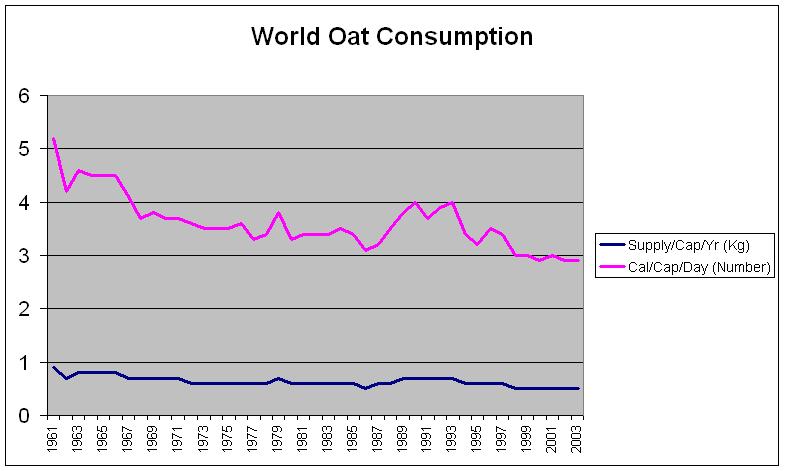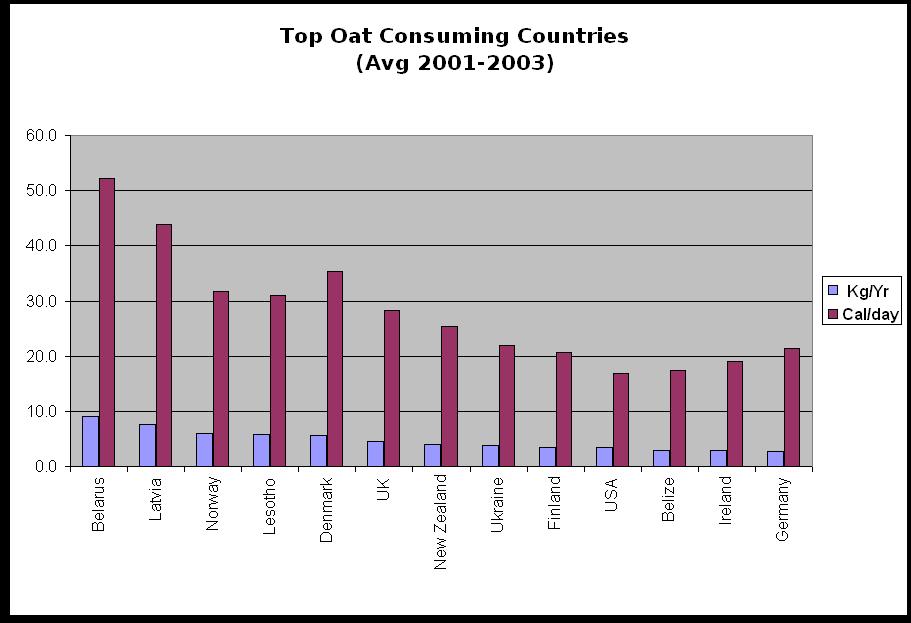![]() Species |
Rice |
Maize |
Wheat |
Barley |
Oats |
Foxtail Millet |
Pearl Millet |
Rye |
Sorghum |
Wild Rice |
Brachypodium |
Oryza Species |
Grape |
Arabidopsis
Species |
Rice |
Maize |
Wheat |
Barley |
Oats |
Foxtail Millet |
Pearl Millet |
Rye |
Sorghum |
Wild Rice |
Brachypodium |
Oryza Species |
Grape |
Arabidopsis
![]() Oat Introduction |
Facts |
Anatomy | Taxonomy |
Agronomic Statistics |
Research |
Education |
Nutrition |
Recipes |
News |
Germplasm Resources |
Gramene Statistics |
Gramene Queries
Oat Introduction |
Facts |
Anatomy | Taxonomy |
Agronomic Statistics |
Research |
Education |
Nutrition |
Recipes |
News |
Germplasm Resources |
Gramene Statistics |
Gramene Queries
 Fig 1. |
 Fig 2. |
| Globally oats, at first, may seem like a very insignificant crop. Collectively oats supply only 3 calories a day on average for each person on this earth (Figure 1, above left). However, not all countries use oats as a source of nutrition, and when we look more closely at individual countries that rely on oats we can see that oats do, indeed, provide significant nutrition to some cultures. For example, Figure 2 (above right) shows the top oat consuming countries. In Belarus, oats contribute over 500 calories a day to the average diet!
But the great majority of oats are used for animal feed (see Figure 3, right) (mostly poultry and horses). Therefore, oats also contribute indirectly to most people's lives through this another form. |  |
Whole oats (retain the hull) are generally used for animal feed. Although oats are hulled before human consumption, the bran remains on the grain and they retain the sources of their nutrients and fiber (10). After hulling they are processed into many forms, including, groats (the hulled oats), steel-cut (Irish) oats, rolled oats (old fashioned oatmeal), quick oats (quick oatmeal), instant oats (instant oatmeal), oat bran, and oat flour (1, 10, 12). Some people with Celiac Disease (sensitivity to gluten) have found that the gluten levels in oats is low enough to be tolerated in their diets (10, 11). However, oats are considered to be in the category called "gluten grains", and wheat-sensitive individuals are recommended to avoid them in their diet (6). Of all the grains, oats have some of the highest protein levels (12-24%) equal to meat, milk and eggs (11). But, due to their slightly higher fat content (compared to other grains,) they will turn rancid more quickly (6) and should be stored in the freezer, or purchased in small quantities. As a general rule, groats cook similarly to rice, with 3 parts water to 1 part grain, for about 50 minutes. The other forms of oats, however, generally call for only 2 parts water to one part grain, as well as shorter cooking times (6).
| |
References: